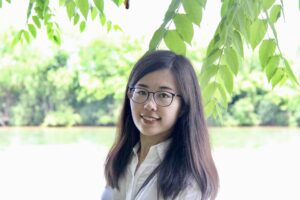Every day needs a night: study examines impact of artificial light on life cycle of trees

While taking a flight one evening, Assistant Professor of Earth and Environmental Sciences Lin Meng observed that the landscape outside of her window was lit up entirely by artificial light. In that moment, a thought crossed her mind: artificial light is everywhere, but what are the ecological consequences?
Meng explored that question in a recent study funded by NASA that examined how artificial light at night (ALAN) effects the life cycle of trees, which evolved under natural day-night cycles.
“While temperature and precipitation are well-known drivers of plant phenology, light—especially artificial light—remains an underappreciated but rapidly growing environmental force,” Meng said. “As cities expand and light pollution increases, I saw a critical need to understand how this affects the seasonal rhythms of vegetation.”
The study found that ALAN has a large impact on phenological events, especially the end of the growing season in fall. Meng said the magnitude of this effect is comparable to climate change, which means that ALAN may be subtly altering how long trees stay active during the year.
“Trees and other plants have evolved in a world with natural light-dark cycles, and disrupting that rhythm could alter key ecological processes, like nutrient cycling, species interactions, and even climate feedbacks,” Meng said. “I’d like to see this research inform urban planning and lighting policy, encouraging the use of more environmental-friendly and sustainable lighting solutions.”
Looking ahead, Meng and her team are working on a follow-up study to evaluate how urban lighting policies aimed at reducing ALAN in New York City and D.C. are actually performing in practice.
“The encouraging part is that this is a solvable problem,” Meng said. “Unlike some other global challenges, light pollution is reversible. The solution can be as simple as flipping a switch—being more mindful of lighting in our homes, offices, parks, and public spaces. Every day needs a night. If we work together to save the night, we’re also protecting ecosystems, biodiversity, and even our own health. It’s a small step with the potential for a big impact.”
The full paper, “Artificial light at night: an underappreciated effect on phenology of deciduous woody plants,” can be found on PNAS Nexus.
